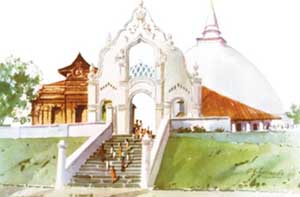 |

31st January 1999 |
News/Comment| Editorial/Opinion| Business| Sports | Mirror Magazine |
Kelaniya Maha Perahera is todayFrom the day you were born…The last line in a poem which comes in Kelani Hella meant for pilgrims making their trek to Kelaniya temple in keeping with the ancient custom of visiting places of worship, advises them that the sins they acquired from the day they were born would be gone if they worship at Kelaniya once. The poet's exaggeration is an attempt to increase the level of devotion of the pilgrim. Traditionally Buddhist devotees recite verses as they proceed, often
on foot, to venerated places. It is a constant reminder of the importance
of visiting a particular place of worship. In this case it is the Kelaniya
Raja Maha Vihara, a place hallowed by Lord Buddha during his third and
final visit to Sri Lanka, eight years after gaining Enlightenment. Kelani Hella whose author is unknown contains 62 verses each ending with the word 'Kelaniya' and is believed to have been written in the Kandyan era. January is synonymous with Kelaniya. Its history goes back over 2575 years. Mahavamsa records that the original dagoba at Kelaniya enshrined a gem studded throne on which the Buddha sat and preached to the laity who gathered along with their king, Maniakkhika. Kelaniya is quoted as a place of worship even by Arahat Mahinda and the Mahavamsa mentions Kelaniya as an independent kingdom in the 2nd century B.C. It was the principal place of worship in the Kingdom of Maya and with the Kelani river flowing through, it was a key commercial town. Pujavaliya and Rajavaliya mention Yatala Tissa as the first administrator of Kelaniya. He is credited with the erection of the rather unusual dagoba in the shape of a paddy heap. Kelaniya had its ups and downs due to foreign invasions from time to time but records describe how Sinhalese kings resurrected the temple no sooner peace was restored. Mention is made of King Vijayabahu (1232 – 1236 A.D) who saved the country from a Magha invasion, and of King Parakramabahu II (1236-1270) rebuilding the temple. Several Sandesa Kavyas mention Kelaniya as an important city. The Mayura, Tisara, Hansa, Selalihi and Kokila Sandesa Kavyas describe the grandeur of Kelaniya. A detailed description of the Kelaniya temple and its features are vividly portrayed in the Selalihini Sandesa. With the advent of the Portuguese, Kelaniya was totally destroyed with the entire city being given over to Franciscan fathers in 1555. The trend continued during the Dutch period too until in 1780 they allowed King Kirti Sri Rajasinghe to renovate the temple. This was a move to curry favour with the king. What remained at the time was the dilapidated chaitya. The king with the advice of the Most Venerable Welivita Sri Saranankara Sangharaja renovated the temple. The temple is famous for its image of the reclining Buddha and two seated Buddha images, and wall paintings depicting important events in the life of the Buddha, the history of Buddhism in Sri Lanka and Jataka tales. Geometrically patterned ceiling paintings in the main hall are of artistic value. The brilliant work of painter Soliyas Mendis in the early part of this century, occupies the new wing of the temple. Following a style of his own, Mendis spent twenty years in creating a fine set of murals including significant events in Sri Lankan history. Relying solely on local raw materials he 'invented' his own colours. He formed the yellow, red and brown from clay and blue and green from the bark of trees. He introduced a totally new indigenous tradition without any western influence. The colourful Duruthu Perahera is held annually to commemorate the first visit of the Buddha to Sri Lanka and is generally organised to coincide with the Duruthu Full Moon Poya day. This year, however, with two full moon Poya days falling in January, the Perahera is being held during the second full moon day (today). The Maha Perahera was held on January 30 with the Uda Maluwa Perahera being held on the two previous days. The origin of the Perahera dates back to the year 1927 when Helena Wijewardena of Sedawatta Walauwa took the initiative in organising it as part of reviving the Raja Maha Vihara activities. Second only to the Kandy Esala Perahera, the Kelaniya Duruthu Perahera continues to maintain the age old religious and cultural traditions and takes the form of a Buddhist cultural festival. Following the acceptance of a proposal by Parliament to declare Kelaniya as a sacred city in 1952, work began in 1958 with the laying of the foundation stone for the construction of buildings in the sacred city. Today Kelaniya enjoys that status. – D C Ranatunga |
||
 |
More Plus *De Richlieu goes to Ceylon
Front Page| News/Comment| Editorial/Opinion| Business| Sports | Mirror Magazine |
|
 |
|
|
